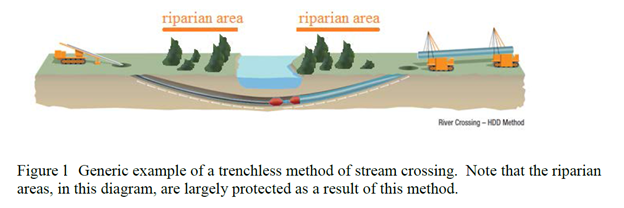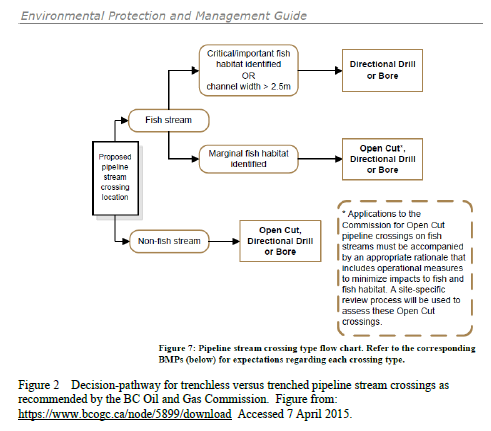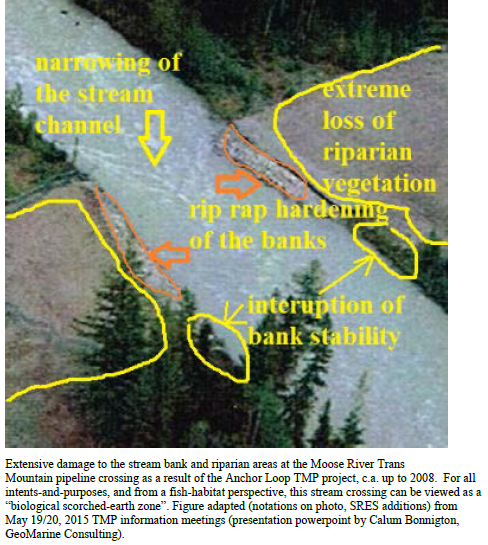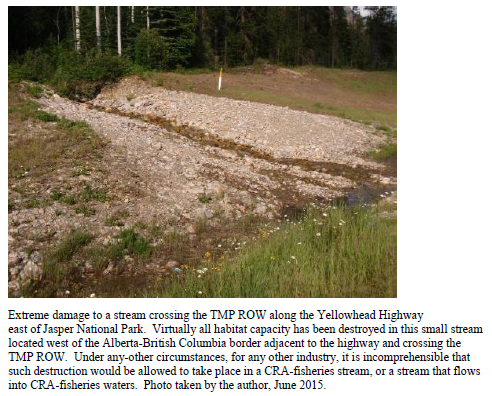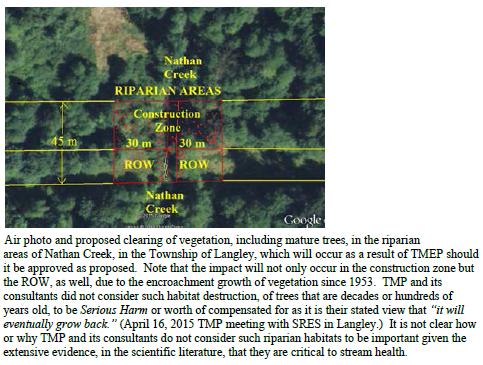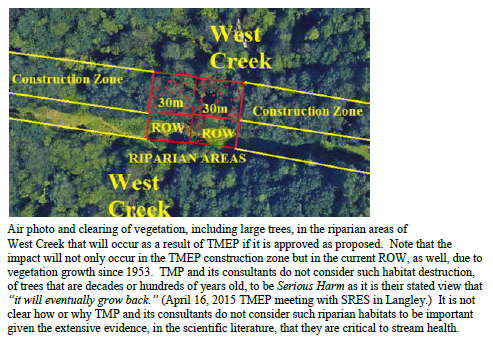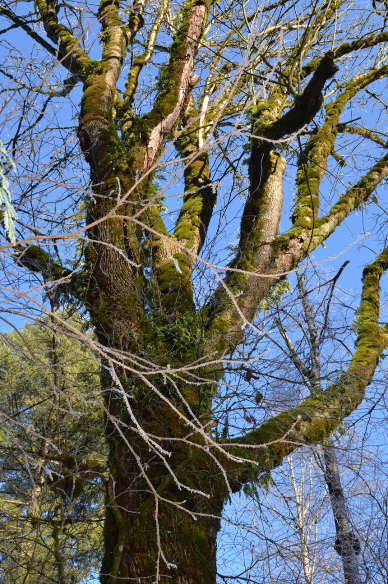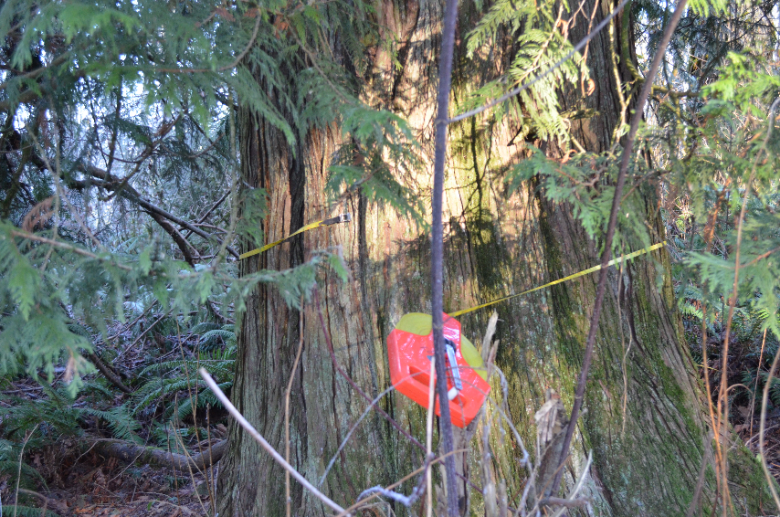Overview
The following provides an overview of the major points of the conversation relating to the SRES concerns associated with the Trans Mountain Expansion Project (TMEP). Members of the SRES executive attended this meeting along with their environmental scientist. Main points of concern are outlined as follows.
- Trenchless Crossings/Directional Drilling
Trans Mountain Expansion Project (TMEP) must be required to use trenchless crossings for all streams with high-fish value habitats.
- Compensation and Offsets
Where damage to ecosystems (including aquatic, riparian and terrestrial), due to TMEP, cannot be mitigated, fair and reasonable compensation must be determined and provided by the Proponent.
- Models for Compensation and Offsets
There are a number of ways that compensation can be achieved for the damage that cannot be mitigated and that will occur due to the impacts that TMEP will accrue. This can include a Legacy Fund as well as land-purchase offsets
- Historic Impacts
SRES remains of the opinion that Social License for the TMEP Expansion can only be achieved when TMEP moves to reconcile outstanding historical grievances. This position is immutable.
- Pre- and Post-Construction Environmental Audits
SRES takes the position that there needs to be third party audits put in place, to allow external-party professionals, to review and comment on the TMEP reports, assessments, proposals and mitigation/compensation. The Proponent must pay for the costs.
Trenchless Crossings/Directional Drilling
SRES is of the position TMEP must be required to use trenchless crossings (Figure 1) for all high-fish value habitats at stream crossings. Key habitats that will be destroyed, and not mitigated, include riparian (edge vegetation) features. This requirement includes, but not exclusively, the Salmon River, Nathan and West creeks (in the Township of Langley) as well as many other watercourses the length of the pipeline.
This position is consistent with past recommendations by Fisheries and Oceans Canada, the Canadian Association of Petroleum Producers (CAPP) and the BC Oil and Gas Commission to use this methodology to protect habitats at high-value stream crossings (Figure 2).
It is not clear why the fisheries agencies (DFO), the Proponent and its Consultants refused to adhere to these requirements in the Proposal and ancillary comments submitted to the National Energy Board Panel.
For the recent Anchor Loop portion of the project, which passes through Jasper National Park and Mt Robson Provincial Park, damage to the riparian areas were extensive and not mitigated. This damage is still extant (Figure 3).
Compensation and Offsets
Where damage to ecosystems (including aquatic, riparian and terrestrial), due to TMEP, cannot be mitigated, fair and reasonable compensation must be determined and provided by the proponent. This was not adequately addressed as part of the proposal by TMEP to the NEB, or in the recommendations set out by the NEB.
The expected-footprint impact by TMEP, including the Anchor Loop, was calculated to be about 50,000,000 m2 of landscape (including both aquatic and terrestrial—1,100 km X 1,000 m/km X 45 m) between Alberta and Burnaby, British Columbia. Furthermore, the impact of damage of the vegetation to the critical riparian area of TMEP streams in British Columbia was determined to be approximately 675,000 m2 (250 streams X 30 m riparian depth X 45 m project width X 2 sides to each stream), less the area for the handful of streams where trenchless is proposed.
For the Township of Langley, extensive damage will occur to riparian areas in West and Nathan creeks (Figure 4) and possibly the Salmon River as well.
This landscape damage is not being adequately mitigated under the TMEP proposal and requires compensation.
Models for Compensation and Offsets
There are a number of ways that compensation can be achieved for the unmitigated damage that will occur due to the damage that TMEP will accrue. This can include a Legacy Fund as well as land-purchase offsets.
Within the Township of Langley watersheds, there are numerous examples of mature, second-growth tree destruction that will be destroyed in both the riparian and terrestrial zones that cannot be directly mitigated (e.g., trees >10 feet diameter; Figures 4, 5) and these need to be replaced via offsets.
Most importantly, TMEP and its Consultants have not proposed any meaningful compensation, in their proposals for these expected losses. Neither the NEB, nor DFO, are holding the Proponent to providing such an offset.
There are a number of compensation models that can be adapted to TMEP that are currently used in British Columbia and around North America in the resource-extraction sector. They are currently being used to address impacts to the environment in mining, forestry, and the electricity industries. Some of these have been discussed at the NEB Proposal level, but do not meaningfully include riparian impacts or losses of large trees in urban forests for example from Hope to Burnaby.
Historic Impacts
The impacts arising from the historic 1953 TMPL construction, the cumulative effects of the proposed TMEP, and subsequent cumulative operational impacts of TMEP need to be addressed by such compensation. TMEP has repeatedly refused to address unmitigated damage sustained from the original pipeline, stating that it will not allow the impacts associated with the original project to be “on the table”. The impact by the original project was extensive and damaging to aquatic resources. SRES remains of the opinion that social license for the TMEP Expansion can only be achieved when TM moves to reconcile outstanding historical grievances.
There is now precedent in the resource extraction industries for restoration of historical impacts. This includes BC Hydro (Fish and Wildlife Compensation Program, Bridge-Coastal Compensation Program, Peace-Williston Fish and Wildlife Compensation Program, Columbia Basin Fish and Wildlife Compensation Program), forestry (Forest Renewal BC, Watershed Restoration Program) and mining (Teck Resources; purchase of 7,000 ha for conservation).
Nowhere has TMEP proposed to provide adequate compensation or offsets for urban forests, located between Hope and Burnaby, which have been destroyed by this project.
Pre- and Post-Construction Environmental Audits
If this pipeline approval goes through, then both the pre- and post-construction requirements are even more critical than the initial environmental assessments that made up the application to the NEB itself. We note that in our submission to the NEB, the failure of mitigation in the Anchor Loop section of this project was extensive and documented by SRES.
In the pre-construction stage the NEB has imposed the 155 conditions that TMEP is obligated to address. The NEB is responsible for verifying that the company complies with all the conditions.
However, nowhere is there an opportunity or requirement for independent experts to come forward to counterpoint what TMEPs’ consultations put together for their proposal.
There has been some Governmental oversight, but we question the rigor of this work and have the view that the agency environmental staff are under staffed and do not have the resources to adequately address this.
SRES takes the position that there needs to be third party audits put in place, to allow external-party professionals to review and comment on the TMEP reports, assessments, proposals and mitigation/compensation.
Further this should not be at any cost to the Canadian Taxpayer.
There needs to be funding in place ex ante to cover the costs of these audits, and TMEP should cover this bill.
Capacity and the cost for post-construction monitoring for the life of the project
Given the NEB and DFO do not have the resources to effectively monitor this pipeline for the next 50 years, a fund should be set up to pay for the assessments so as to have ongoing, vigorous monitoring.
This should not be at the expense of the Canadian taxpayer, therefore the TMEP needs to be required to pay for these efforts; all post-construction monitoring, and any subsequent mitigation that is shown to be outstanding.
For the Anchor Loop component of this project, TMEP has developed the Environmental Stewardship Program. While TMEP proudly tout they have put in $2.2 million, and while some good things have been done this initiative, the fund is still woefully inadequate. This monetary value, for Anchor Loop, works out to a paltry sum of $44 000 per year over 50 years.
SRES submits that if TMEP’s funding the costs of on-going monitoring is not entrenched in the process it is putting into place a real Moral Hazard/Risk Ownership issue that will continue for the life of the project. (“Moral Hazard” means the lack of incentive to guard against risk where one is protected from its consequences,).
SRES is asking that the Moral Hazard/Risk Ownership issue be avoided by shifting the Burden of these costs from the Canadian Tax payer to TM and that they be fixed in the Proposal ex ante.
SRES recommends that a fair, but sufficiently large, bond be deposited by TMEP to cover post-construction monitoring and any subsequent mitigation failures. This should also cover the cost of external-independent monitoring auditors.
SRES is of the opinion that these few points laid out above are bare-minimum requirements if this project should be allowed to proceed.
Figure 3. Damage to streams in the Anchor Loop due to the failure to use trenchless construction.
Figure 4. Damage that will occur to both the upland terrestrial and the riparian areas at West and Nathan creeks should the TMEP proceed as proposed.
Figure 5. Examples of large second growth trees that will be destroyed by TMEP in the West Creek area. This is representative of many areas of the lower mainland, Hope to Burnaby, where second growth, or residual old growth, will be removed as a function of this project. No reasonable compensation has been offered by TMP or required by the environmental agencies.
